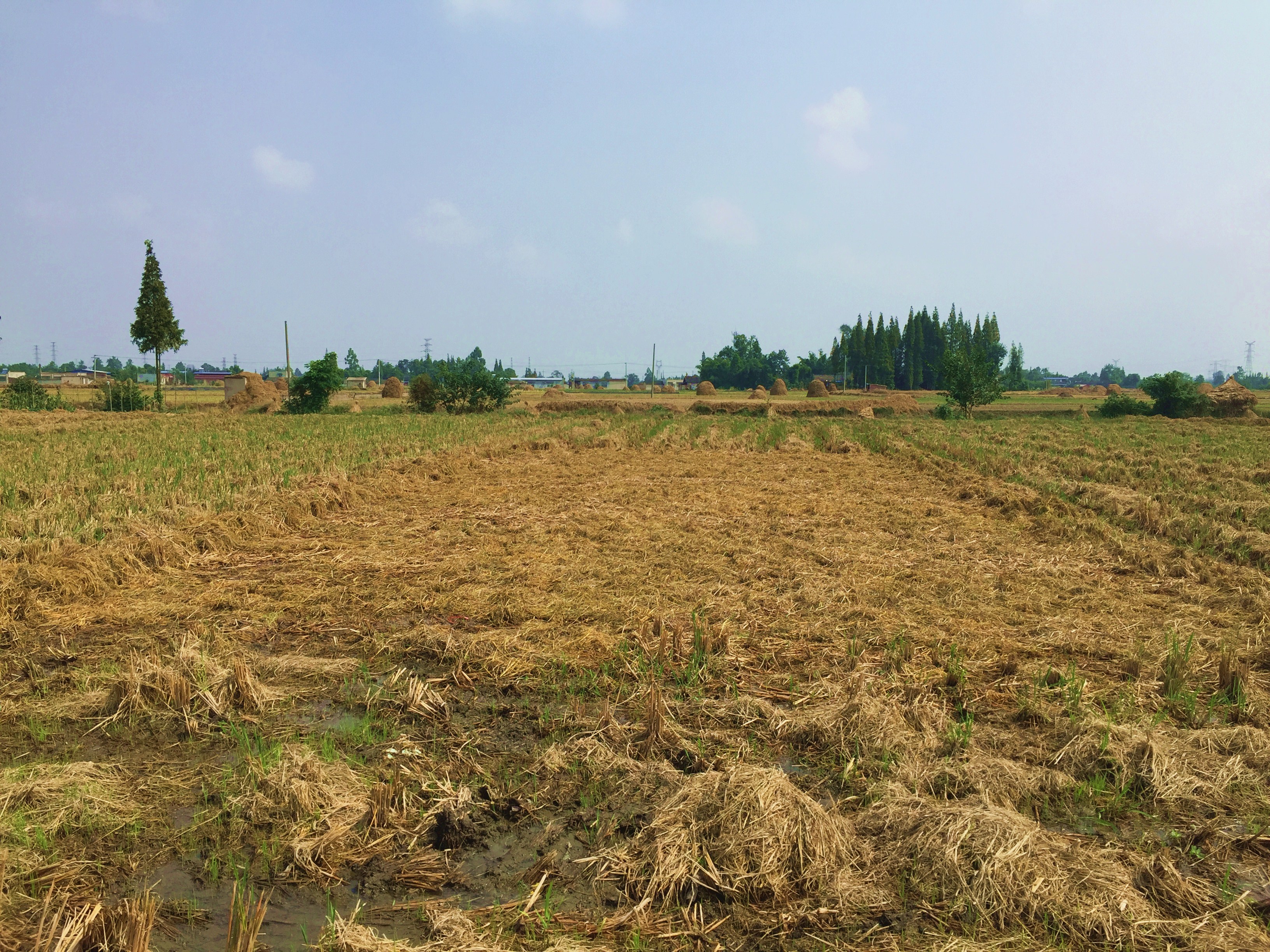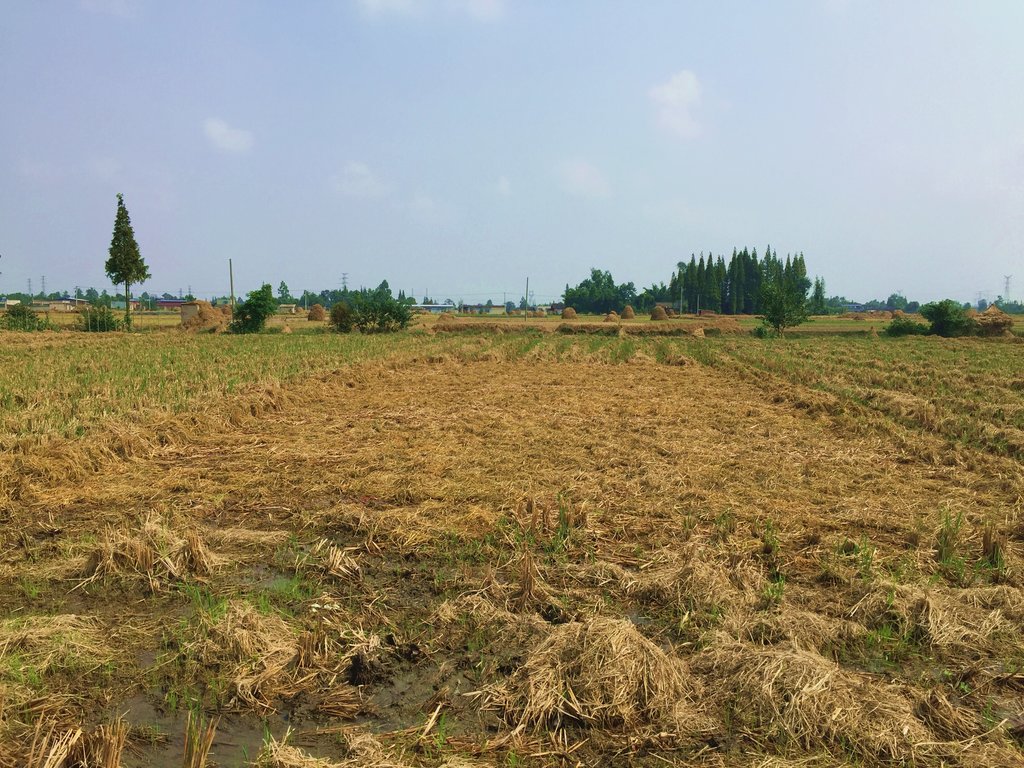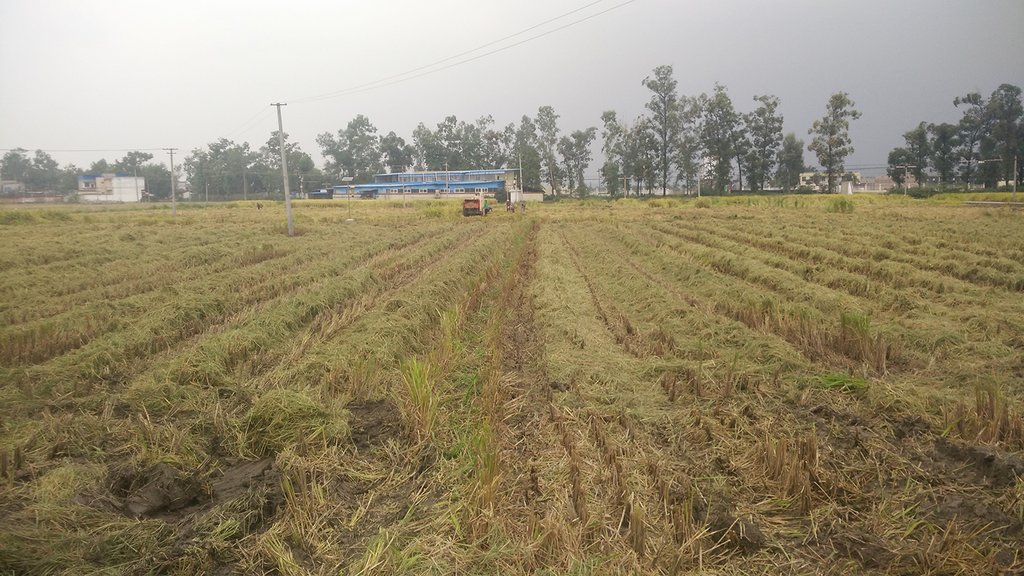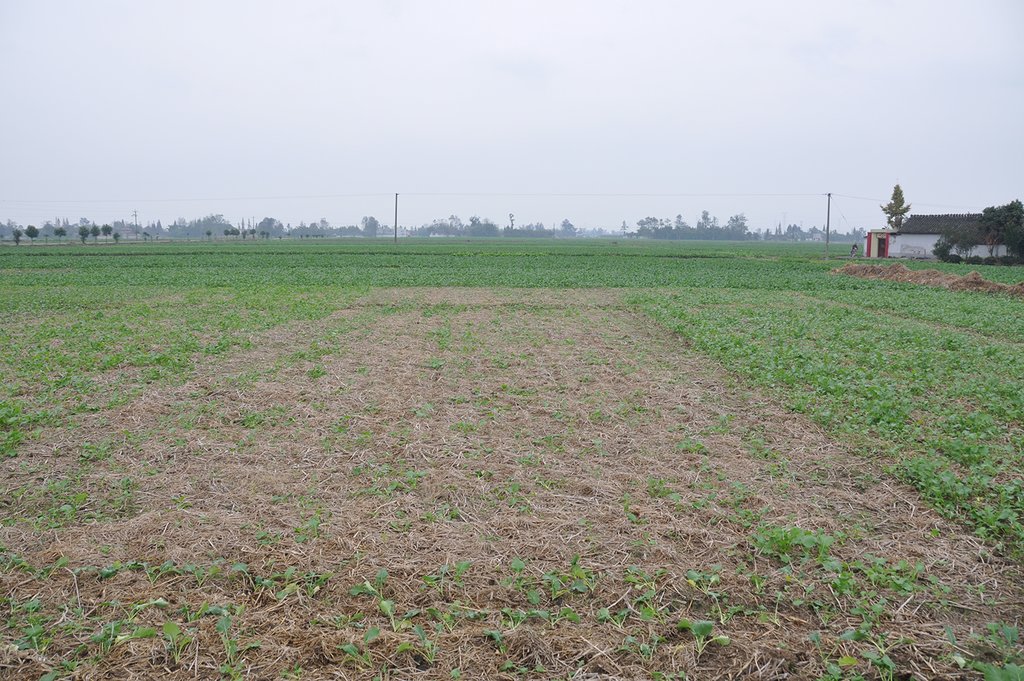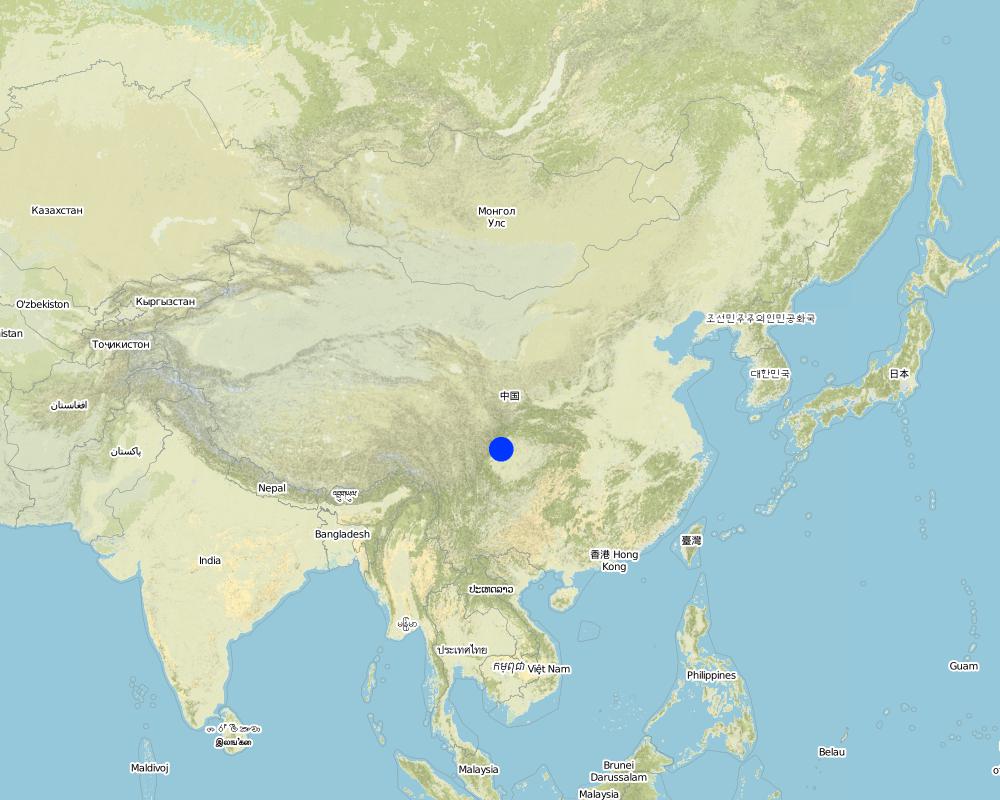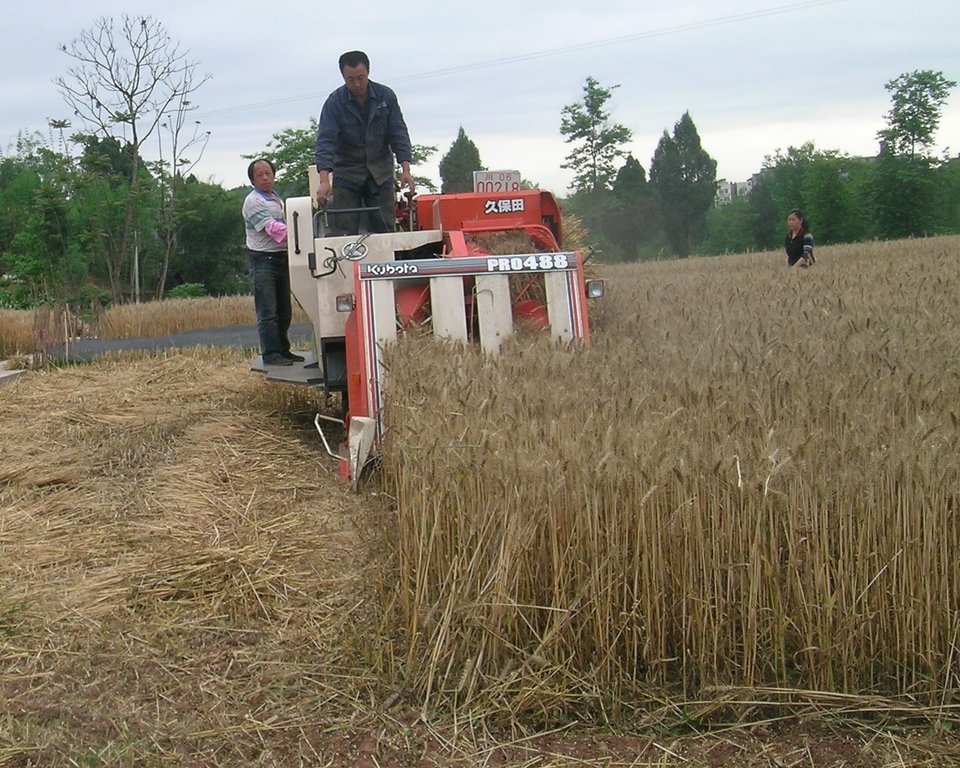Straw residues left on field after harvest and no tillage [Chine]
- Création :
- Mise à jour :
- Compilateur : Song Guo
- Rédacteur : –
- Examinateurs : Gudrun Schwilch, Ursula Gaemperli, Alexandra Gavilano
No tillage planting
technologies_3239 - Chine
Voir les sections
Développer tout Réduire tout1. Informations générales
1.2 Coordonnées des personnes-ressources et des institutions impliquées dans l'évaluation et la documentation de la Technologie
Personne(s)-ressource(s) clé(s)
Spécialiste GDT:
Hongzhu Fan
Soil and Fertilizer Institute of the Sichuan Academy of Agricultural Sciences
Chine
exploitant des terres:
Wu Shengde
Chine
Nom du projet qui a facilité la documentation/ l'évaluation de la Technologie (si pertinent)
Interactive Soil Quality assessment in Europe and China for Agricultural productivity and Environmental Resilience (EU-iSQAPER)Nom du ou des institutions qui ont facilité la documentation/ l'évaluation de la Technologie (si pertinent)
‒ Soil and Fertilizer Institute of the Sichuan Academy of Agricultural Sciences (SFI) - Chine1.3 Conditions relatives à l'utilisation par WOCAT des données documentées
Le compilateur et la(les) personne(s) ressource(s) acceptent les conditions relatives à l'utilisation par WOCAT des données documentées:
Oui
1.4 Déclaration sur la durabilité de la Technologie décrite
Est-ce que la Technologie décrite ici pose problème par rapport à la dégradation des terres, de telle sorte qu'elle ne peut pas être déclarée comme étant une technologie de gestion durable des terres?
Non
2. Description de la Technologie de GDT
2.1 Courte description de la Technologie
Définition de la Technologie:
Method of this agricultual technology the rice straw will be left on the field after mechanized harvesting. Succession crop, such as rape, wheat or potato, were seeded directly under no tillage condition. Both measures aim at better soil regeneration and soil conditions for agriculture and subsequently increased yield and less soil degradation.
2.2 Description détaillée de la Technologie
Description:
The SLM practice (straw mulching and no tillage) is applied in the Chengdu Plain Paddy Soil. The Chengdu plain has mild climate and abundant rainfall. It belongs to the warm humid subtropical Pacific monsoon climate zone.The main types of soil in the Chengdu plain are paddy soil and purple soil.The total land resources of the Chengdu plain are 1331800 hectares, and the per capita land resources are about 0.1044 hectares per person. In 2010, the total amount of cultivated land in the Chengdu plain was 478069 hectares, accounting for 35.90% of the area of the plain, accounting for 42.36% of the total area of agricultural land in the region, and the per capita arable land area was only about 0.0375 hectares. The Chengdu Plain is an important grain production base in Sichuan. Rice field-upland field rotation (rice - wheat, rice - rapeseed) is an important agricultural system.
On the case study area, the N, P and K fertilizers were applied as urea, calcium superphosphate and potassium chloride at the rates of 120-150 kg N ha-1, 75-120 kg P2O5 ha-1,and 75-120 kg K2O ha-1, during every crop. During crop season, the rate of 60% of N, 100% of P, and 50% of K fertilizers were applied as base fertilizer, while remaining 40% of N and 50% of K were used as top dressing fertilizer. The main measures of this SLM is rice straw or wheat straw mulching while havesting (leaving the straw after havest scattered on the field). Crops were harvested by a combine harvester (Kuotian combine harvester, model PR0488), then straw and stubble of crops were left at size of less than 20 cm in the field. The seeding of succession crop such as wheat and oil seed rape is done by a direct seeding machine. The land users are working eighter with a contractor or they use their own machines and labour force. The purposes of this technology were to increase production and improve soil fertility. Although plough layer can become shallow by long-term no tillage cultivation, more and more land users like this technology because it promises increased grain yield, reduction of fertilizers (and subsequently cost), and it improves soil physical, chemical and biological properties of soil. Thus, it is expected that the measures of this SLM-Technology ends up in improved soil moisture, higher diversity of soil life and finally soil fertility .
2.3 Photos de la Technologie
2.5 Pays/ région/ lieux où la Technologie a été appliquée et qui sont couverts par cette évaluation
Pays:
Chine
Région/ Etat/ Province:
Basin plain, Chengdu, Sichuan
Autres spécifications du lieu:
Guanhan City, Wenjiang District, Chongzhou City
Spécifiez la diffusion de la Technologie:
- répartie uniformément sur une zone
S'il n'existe pas d'informations exactes sur la superficie, indiquez les limites approximatives de la zone couverte:
- 100-1 000 km2
Commentaires:
This long-term straw mulch experiment was started in the 2005. This site is situated in subtropical monsoon region with anverage annual temperature of about 16.3℃, 281 days frost free. Annual precipitation is about 890mm.
Map
×2.6 Date de mise en œuvre de la Technologie
Si l'année précise est inconnue, indiquez la date approximative: :
- il y a entre 10-50 ans
2.7 Introduction de la Technologie
Spécifiez comment la Technologie a été introduite: :
- au cours d'expérimentations / de recherches
Commentaires (type de projet, etc.) :
The current case study bases only on a test area within the scope of the iSQAPER Project. A long-term straw mulch and fertilization experiment was initiated in 2005 at Sichuan Academy of Agricultural Sciences Soil and Fertilizer Research Institute’s Guanghan agricultural experiment station in Sichuan province, southwest China. Thus, effects of long-term fertilization and straw much on crop yields, soil physical and chemical properties under rice-rapeseed rotation were assessed in a paddy soil
3. Classification de la Technologie de GDT
3.1 Principal(aux) objectif(s) de la Technologie
- améliorer la production
- réduire, prévenir, restaurer les terres dégradées
- préserver l'écosystème
- conserver/ améliorer la biodiversité
3.2 Type(s) actuel(s) d'utilisation des terres, là où la Technologie est appliquée

Terres cultivées
- Cultures annuelles
Cultures annuelles - Précisez les cultures:
- cultures oléagineuses - tournesol, colza, autres
- wheat, rice
Nombre de période de croissance par an: :
- 2
Est-ce que la rotation des cultures est appliquée?
Oui
Si oui, veuillez préciser:
Method of this agricultual technology the rice straw will be left on the field after mechanized harvesting. Succession crop, such as rape, wheat or potato, were seeded directly under no tillage condition.
3.4 Approvisionnement en eau
Approvisionnement en eau des terres sur lesquelles est appliquée la Technologie:
- mixte: pluvial-irrigué
3.5 Groupe de GDT auquel appartient la Technologie
- système de rotation (rotation des cultures, jachères, agriculture itinérante)
- Amélioration de la couverture végétale/ du sol
- perturbation minimale du sol
3.6 Mesures de GDT constituant la Technologie

pratiques agronomiques
- A1: Couverture végétale/ du sol
- A2: Matière organique/ fertilité du sol
- A3: Traitement de la couche superficielle du sol
3.7 Principaux types de dégradation des terres traités par la Technologie

dégradation chimique des sols
- Cn: baisse de la fertilité des sols et réduction du niveau de matière organique (non causée par l’érosion)

dégradation physique des sols
- Pc: compaction
- Pk: scellage et encroûtement
3.8 Prévention, réduction de la dégradation ou réhabilitation des terres dégradées
Spécifiez l'objectif de la Technologie au regard de la dégradation des terres:
- prévenir la dégradation des terres
4. Spécifications techniques, activités, intrants et coûts de mise en œuvre
4.1 Dessin technique de la Technologie
Spécifications techniques (associées au dessin technique):
The SLM practice (straw mulching while harvesting and no tillage) is applied in the Chengdu Plain paddy soil. The main measures of this SLM method is straw mulching while harvesting and no tillage. Crops are harvested by machine (actually in this case study by Kuotian combine harvester/model was PR0488), and then straw and stubble were left at size of less than 20 cm on the soil surface. The N, P and K fertilizers to the succession crop were applied in form of urea, calcium superphosphate and potassium chloride at the rates of 120-150 kg N ha-1, 75-120 kg P2O5 ha-1, and 75-120 kg K2O ha-1. Rates of 60% of N, 100% of P and 50% of K fertilizers were applied as base fertilizers, while the remaining 40% of N and 50% of K were used as top dressing fertilizers. After previous crop harvest of rice the succession crop as for example wheat, oil rape, maize will be seeded directly under no tillage condition.
Auteur:
Hongzhu Fan
Date:
30/10/2017
4.2 Informations générales sur le calcul des intrants et des coûts
Spécifiez la manière dont les coûts et les intrants ont été calculés:
- par superficie de la Technologie
Indiquez la taille et l'unité de surface:
1 hectare
autre/ monnaie nationale (précisez):
Renminbi (RMB)
Indiquez le taux de change des USD en devise locale, le cas échéant (p.ex. 1 USD = 79.9 réal brésilien): 1 USD = :
6,6
Indiquez le coût salarial moyen de la main d'œuvre par jour:
120 RMB per day
4.5 Activités d'entretien/ récurrentes
| Activité | Calendrier/ fréquence | |
|---|---|---|
| 1. | mechanized harvesting | August or September |
| 2. | spreading the straw residues after havest on the field | after harvest of crops |
| 3. | fertilization | October |
| 4. | no tillage and direct seeding | October |
4.6 Coûts et intrants nécessaires aux activités d'entretien/ récurrentes (par an)
| Spécifiez les intrants | Unité | Quantité | Coûts par unité | Coût total par intrant | % du coût supporté par les exploitants des terres | |
|---|---|---|---|---|---|---|
| Main d'œuvre | All reccurent labour (above) is done within the familiy* | person-day | 0,5 | 120,0 | 60,0 | 100,0 |
| Equipements | harvester (machine from contractor without labour force)* | ha | 1,0 | 3000,0 | 3000,0 | 100,0 |
| Equipements | Direct seeding machine (from contractor without labour force)* | ha | 1,0 | 1800,0 | 1800,0 | |
| Matériel végétal | seed (weat, rape) | kg | 120,0 | 2,0 | 240,0 | 100,0 |
| Engrais et biocides | urea | kg | 280,0 | 3,0 | 840,0 | 100,0 |
| Engrais et biocides | calcuim superphosphate | kg | 810,0 | 1,0 | 810,0 | 100,0 |
| Engrais et biocides | potassium chloride | kg | 200,0 | 3,5 | 700,0 | 100,0 |
| Coût total d'entretien de la Technologie | 7450,0 | |||||
| Coût total d'entretien de la Technologie en dollars américains (USD) | 1128,79 | |||||
Commentaires:
*The labour (for harvesting, fertilizering and seeding ) is unpaid when those were done by farm familiy.
But in China, there is no contractor to do all work (for harvesting, fertilizing and seeding). If all works done by a contractor, farms will give up planting crops. Usually, a contractor provide machine to farm, but no labor. Farm members engaged in agricultural production will do most of the work by themselves in order to save cost.
4.7 Facteurs les plus importants affectant les coûts
Décrivez les facteurs les plus importants affectant les coûts :
Most of important factor affecting the costs of this technology is the type of machine used for harvest. (E.g. cost is high by the mini combine harvester because of the low efficiency).
5. Environnement naturel et humain
5.1 Climat
Précipitations annuelles
- < 250 mm
- 251-500 mm
- 501-750 mm
- 751-1000 mm
- 1001-1500 mm
- 1501-2000 mm
- 2001-3000 mm
- 3001-4000 mm
- > 4000 mm
Zone agro-climatique
- subhumide
5.2 Topographie
Pentes moyennes:
- plat (0-2 %)
- faible (3-5%)
- modéré (6-10%)
- onduleux (11-15%)
- vallonné (16-30%)
- raide (31-60%)
- très raide (>60%)
Reliefs:
- plateaux/ plaines
- crêtes
- flancs/ pentes de montagne
- flancs/ pentes de colline
- piémonts/ glacis (bas de pente)
- fonds de vallée/bas-fonds
Zones altitudinales:
- 0-100 m
- 101-500 m
- 501-1000 m
- 1001-1500 m
- 1501-2000 m
- 2001-2500 m
- 2501-3000 m
- 3001-4000 m
- > 4000 m
Indiquez si la Technologie est spécifiquement appliquée dans des:
- non pertinent
5.3 Sols
Profondeur moyenne du sol:
- très superficiel (0-20 cm)
- superficiel (21-50 cm)
- modérément profond (51-80 cm)
- profond (81-120 cm)
- très profond (>120 cm)
Texture du sol (de la couche arable):
- moyen (limoneux)
Texture du sol (> 20 cm sous la surface):
- grossier/ léger (sablonneux)
Matière organique de la couche arable:
- moyen (1-3%)
Si disponible, joignez une description complète du sol ou précisez les informations disponibles, par ex., type de sol, pH/ acidité du sol, capacité d'échange cationique, azote, salinité, etc.
Soil type is alluvial soil, PH is 5.5, SOC 31.3g/kg, N 2.02g/kg,P 1.04g/kg, K 7.69g/kg, available nitrogen 189.7mg/kg, available phosphorus 12.6mg/kg, ammonium acetate extractable potassium95.5mg/kg.
5.4 Disponibilité et qualité de l'eau
Profondeur estimée de l’eau dans le sol:
< 5 m
Disponibilité de l’eau de surface:
moyenne
Qualité de l’eau (non traitée):
eau potable
La salinité de l'eau est-elle un problème? :
Non
La zone est-elle inondée?
Non
5.5 Biodiversité
Diversité des espèces:
- élevé
Diversité des habitats:
- élevé
5.6 Caractéristiques des exploitants des terres appliquant la Technologie
Sédentaire ou nomade:
- Sédentaire
Orientation du système de production:
- exploitation mixte (de subsistance/ commerciale)
Revenus hors exploitation:
- moins de 10% de tous les revenus
Niveau relatif de richesse:
- moyen
Individus ou groupes:
- groupe/ communauté
Niveau de mécanisation:
- mécanisé/ motorisé
Genre:
- femmes
Age des exploitants des terres:
- personnes d'âge moyen
5.7 Superficie moyenne des terres utilisées par les exploitants des terres appliquant la Technologie
- < 0,5 ha
- 0,5-1 ha
- 1-2 ha
- 2-5 ha
- 5-15 ha
- 15-50 ha
- 50-100 ha
- 100-500 ha
- 500-1 000 ha
- 1 000-10 000 ha
- > 10 000 ha
Cette superficie est-elle considérée comme de petite, moyenne ou grande dimension (en se référant au contexte local)?
- moyenne dimension
5.8 Propriété foncière, droits d’utilisation des terres et de l'eau
Propriété foncière:
- état
Droits d’utilisation des terres:
- communautaire (organisé)
Droits d’utilisation de l’eau:
- communautaire (organisé)
Commentaires:
In China, land ownership belongs to the state, but land use rights belong to farm. In other words, farm can decide to plant rice, wheat, or fruit tree in the land, but the farm cannot sell this land.
5.9 Accès aux services et aux infrastructures
santé:
- pauvre
- modéré
- bonne
éducation:
- pauvre
- modéré
- bonne
assistance technique:
- pauvre
- modéré
- bonne
emploi (par ex. hors exploitation):
- pauvre
- modéré
- bonne
marchés:
- pauvre
- modéré
- bonne
énergie:
- pauvre
- modéré
- bonne
routes et transports:
- pauvre
- modéré
- bonne
eau potable et assainissement:
- pauvre
- modéré
- bonne
services financiers:
- pauvre
- modéré
- bonne
6. Impacts et conclusions
6.1 Impacts sur site que la Technologie a montrés
Impacts socio-économiques
Production
production agricole
Quantité avant la GDT:
14.9 t ha-1*
Quantité après la GDT:
15.5 t ha-1*
Commentaires/ spécifiez:
* yield for rape
Wheat yield were 6.3 t ha-1 before SLM and 6.7 t ha-1 after SLM, respectively. Rice yield were 8.6 t ha-1 before SLM and 8.8 t ha-1 after SLM, respectively.
gestion des terres
Commentaires/ spécifiez:
No tillage is an important way to reduce cost by machine plough field. Less fertilizing work and amount of fertilizers by leaving straw on field (straw contains a large amount of C, N, P, and K)
Disponibilité et qualité de l'eau
demande pour l'eau d'irrigation
Commentaires/ spécifiez:
Straw mulching can decreased demand for irrigation water, because water can be keep in the straw, and straw mulching on the soil also can reduced evaporation of water.
Revenus et coûts
dépenses pour les intrants agricoles
Commentaires/ spécifiez:
No tillage is an important way to reduce cost by machine plough field. Less fertilizing work and amount of fertilizers by straw return compared with no straw mulching (straw contains a large number of C, N, P and K. Therefore agricultural inputs can be reduced.
revenus agricoles
Commentaires/ spécifiez:
Do to better yield and reduction of costs.
charge de travail
Impacts socioculturels
connaissances sur la GDT/ dégradation des terres
Commentaires/ spécifiez:
Increased knowledge on the benefits of straw mulching by the land users.
Impacts écologiques
Sols
humidité du sol
Commentaires/ spécifiez:
Due to straw mulching, because the water can be kept in the straw and soil evaporation can be reduced to improved oil cover.
couverture du sol
Commentaires/ spécifiez:
Due to the mulching by straw, the soil remain covered practically the whole year round.
encroûtement/ battance du sol
Commentaires/ spécifiez:
Without ploughing the soil crusting can occur at long term use of the technology (findings from a long-term straw mulch and fertilization experiment was initiated in 2005 at Sichuan Academy of Agricultural Sciences Soil and Fertilizer Research Institute’s Guanghan agricultural experiment station in Sichuan province)
compaction du sol
Commentaires/ spécifiez:
Without ploughing the soil gets more compact at long term use of the technology (findings from a long-term straw mulch and fertilization experiment was initiated in 2005 at Sichuan Academy of Agricultural Sciences Soil and Fertilizer Research Institute’s Guanghan agricultural experiment station in Sichuan province)
cycle/ recharge des éléments nutritifs
matière organique du sol/ au dessous du sol C
Commentaires/ spécifiez:
Due to mulching by rice straw (crop residues)
Biodiversité: végétale, animale
biomasse/ au dessus du sol C
Commentaires/ spécifiez:
Due to mulching by rice straw (crop residues)
diversité animale
Commentaires/ spécifiez:
Due to mulching by rice straw (crop residues), soil life has increased.
espèces bénéfiques
Réduction des risques de catastrophe et des risques climatiques
émissions de carbone et de gaz à effet de serre
Commentaires/ spécifiez:
Traditional burning of rice straw on the fields has been reduced, as straw is needed for mulching. Subsequently the C can be bound within the soil and will not be emitted into the air in form of CO2.
6.2 Impacts hors site que la Technologie a montrés
impact des gaz à effet de serre
Commentaires/ spécifiez:
Traditional burning of rice straw on the fields has been reduced, as straw is needed for mulching. Subsequently the C can be bound within the soil and will not be emitted into the air in form of CO2.
6.4 Analyse coûts-bénéfices
Quels sont les bénéfices comparativement aux coûts d'entretien récurrents (du point de vue des exploitants des terres)?
Rentabilité à court terme:
légèrement positive
Rentabilité à long terme:
positive
6.5 Adoption de la Technologie
- 11-50%
De tous ceux qui ont adopté la Technologie, combien d'entre eux l'ont fait spontanément, à savoir sans recevoir aucune incitation matérielle, ou aucune rémunération? :
- 91-100%
6.6 Adaptation
La Technologie a-t-elle été récemment modifiée pour s'adapter à l'évolution des conditions?
Non
6.7 Points forts/ avantages/ possibilités de la Technologie
| Points forts/ avantages/ possibilités du point de vue de l'exploitant des terres |
|---|
| This technology can improve the yield |
| It can save labour by leaving straw on the field |
| Points forts/ avantages/ possibilités du point de vue du compilateur ou d'une autre personne ressource clé |
|---|
| Straw mulching can increase the soil carbon input, and improve the soil quantity. |
| This technology can reduce land degradation. |
6.8 Faiblesses/ inconvénients/ risques de la Technologie et moyens de les surmonter
| Faiblesses/ inconvénients/ risques du point de vue de l’exploitant des terres | Comment peuvent-ils être surmontés? |
|---|---|
| Soil structure was deteriorated by no tillage cultivation. | tillage |
| Faiblesses/ inconvénients/ risques du point de vue du compilateur ou d'une autre personne ressource clé | Comment peuvent-ils être surmontés? |
|---|---|
| Soil hardening occured, and also a thin impervious layer was built at the soil surface | It could be good to plough up the soil after an interval of 5 years |
| Obstruction of rainwater infiltration | |
| Soil plough layer becomes shallow |
7. Références et liens
7.1 Méthodes/ sources d'information
- interviews/entretiens avec les exploitants des terres
94 people
- compilation à partir de rapports et d'autres documents existants
Quand les données ont-elles été compilées (sur le terrain)?
20/09/2016
7.2 Références des publications disponibles
Titre, auteur, année, ISBN:
Composition of Wheat Rhizosphere Antagonistic Bacteria and Wheat Sharp Eyespot as Affected by Rice Straw Mulching. CHEN Huai-Gu, CAO Qi-Guang, XIONG Gui-Lin, LI Wei, ZHANG Ai-Xiang, YU Han-Shou and WANG Jin-Sheng.2010.
Disponible à partir d'où? Coût?
ScienceDirect. No
Titre, auteur, année, ISBN:
Effects of pre-sowing irrigation and straw mulching on the grain yieldand water use efficiency of summer maize in the North China Plain. Zhenxing Yan, Chao Gao, Yujie Ren, Rui Zong, Yuzhao Ma, Quanqi Li. 2017
Disponible à partir d'où? Coût?
ScienceDirect. No
Titre, auteur, année, ISBN:
Effects of snow cover plus straw mulching on microorganisms in paddy soil during winter.Hao Zhanga,b, Jie Tanga, Shuang Liang.2017
Disponible à partir d'où? Coût?
ScienceDirect. No
Titre, auteur, année, ISBN:
Effects of Non-flooded Cultivation with Straw Mulching on Rice Agronomic Traits and Water Use Efficiency. QIN Jiang-tao , HU Feng , LI Hui-xin , WANG Yi-ping , HUANG Fa-quan , HUANG Hua-xiang.2006
Disponible à partir d'où? Coût?
ScienceDirect. No
Titre, auteur, année, ISBN:
Growth Characteristics and Yield of Late-Season Rice under No-tillageand Non-flooded Cultivation with Straw Mulching. WANG Dong, LI Hui-xin, QIN Jiang-tao, LI Da-ming, HU Feng.2010
Disponible à partir d'où? Coût?
ScienceDirect. No
Titre, auteur, année, ISBN:
Impact of tillage practices on soil bacterial diversity and composition under the tobacco-rice rotation in China. Yanping Lei, Yongliang Xiao, Lifeng Li,Chaoqiang Jiang, Chaolong Zu, Tian Li, and Hui Cao.2017
Disponible à partir d'où? Coût?
ScienceDirect. No
Titre, auteur, année, ISBN:
Nutrient Decomposition Rate and Sugarcane Yield as Influenced by Mung Bean Intercropping and Crop Residue Recycling Tie-Guang He,Li-Rong Su,Yang-Rui Li,Tian-Ming Su2 Fang Qin,Qin Li.2017
Disponible à partir d'où? Coût?
ScienceDirect. No
Titre, auteur, année, ISBN:
Process rates of nitrogen cycle in uppermost topsoil after harvesting in no-tilled and ploughed agricultural clay soil. Merjo Laine . Tobias Ru¨ tting . Laura Alakukku . Ansa Paloja¨rvi . Rauni Stro¨mmer.2017
Disponible à partir d'où? Coût?
ScienceDirect. No
Titre, auteur, année, ISBN:
Research on the effect of straw mulching on the soil moisture by field experiment in the piedmont plain of the Taihang Mountains. LI Man, ZHANG Wei, HE Yu-jiang, WANG Gui-ling.2017
Disponible à partir d'où? Coût?
ScienceDirect. No
Titre, auteur, année, ISBN:
Rice–wheat cropping system: tillage, mulch, and nitrogen effects on soil carbon sequestration and crop productivity Keshav R. Adhikari,Khem R. Dahal,Zueng-Sang Chen,Yih-Chi Tan,Jihn-Sung Lai.2017
Disponible à partir d'où? Coût?
ScienceDirect. No
Titre, auteur, année, ISBN:
Soil Carbon Sequestration and Crop Yields in Rice–Wheat and Sugarcane–Ratoon–Wheat Cropping Systems Through Crop Residue Management and Inoculation of Trichoderma viride in Subtropical India.S. K. Shukla,Swaha Shee,S. K. Maity,S. Solomon,S. K. Awasthi,Asha Gaur,A. D. Pathak,V. P. Jaiswal.2017
Disponible à partir d'où? Coût?
ScienceDirect. No
Titre, auteur, année, ISBN:
成都平原麦稻双免耕秸秆还田技术模式.汤永禄 , 黄钢, 郑家国, 李朝苏,邓先和,付书明.2008
Disponible à partir d'où? Coût?
http://www.cnki.net/. No
Titre, auteur, année, ISBN:
Influence of straw mulching with no-till on soil nutrients and carbon pool management index.CHEN Shang-hong, ZHU Zhong-lin, LIU Ding-hui, SHU Li , WANG Chang-quan.2008
Disponible à partir d'où? Coût?
http://www.cnki.net/. No
7.3 Liens vers les informations pertinentes en ligne
Titre/ description:
Effects of pre-sowing irrigation and straw mulching on the grain yieldand water use efficiency of summer maize in the North China Plain.
URL:
http://dx.doi.org/10.1016/j.agwat.2017.02.017
Titre/ description:
Effects of snow cover plus straw mulching on microorganisms in paddy soil during winter
URL:
http://dx.doi.org/10.1016/j.apsoil.2017.05.023
Titre/ description:
Growth Characteristics and Yield of Late-Season Rice under No-tillageand Non-flooded Cultivation with Straw Mulching
URL:
DOI: 10.1016/S1672-6308(08)60117-1
Titre/ description:
Impact of tillage practices on soil bacterial diversity and composition under the tobacco-rice rotation in China
URL:
DOI 10.1007/s12275-017-6242-9
Titre/ description:
Nutrient Decomposition Rate and Sugarcane Yield as Influenced by Mung Bean Intercropping and Crop Residue Recycling
URL:
DOI 10.1007/s12355-017-0548-0
Titre/ description:
Process rates of nitrogen cycle in uppermost topsoil after harvesting in no-tilled and ploughed agricultural clay soil
URL:
DOI 10.1007/s10705-017-9825-2
Titre/ description:
Rice–wheat cropping system: tillage, mulch, and nitrogen effects on soil carbon sequestration and crop productivity
URL:
DOI 10.1007/s10333-015-0511-1
Titre/ description:
Soil Carbon Sequestration and Crop Yields in Rice–Wheat and Sugarcane–Ratoon–Wheat Cropping Systems Through Crop Residue Management and Inoculation of Trichoderma viride in Subtropical
URL:
DOI 10.1007/s12355-016-0470-x
Liens et modules
Développer tout Réduire toutLiens
Aucun lien
Modules
Aucun module trouvé


